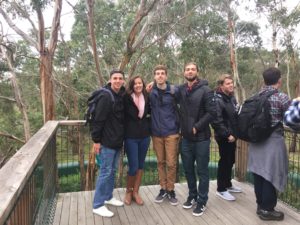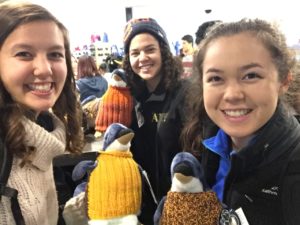 Jessica Fong, Arizona State University’s Barrett in Australia student blogger, writes: Ever since I was accepted into the Barrett in Australia program, all I’ve been able to think about is what it would be like to experience Australian wildlife up close and personal. As we began our travels in Melbourne, I didn’t expect to see any native fauna until we arrived in North Queensland. Well, it turns out I was mistaken!
Jessica Fong, Arizona State University’s Barrett in Australia student blogger, writes: Ever since I was accepted into the Barrett in Australia program, all I’ve been able to think about is what it would be like to experience Australian wildlife up close and personal. As we began our travels in Melbourne, I didn’t expect to see any native fauna until we arrived in North Queensland. Well, it turns out I was mistaken!
On Friday, we took the most incredible excursion just outside of Melbourne to the Koala Conservation Centre. Our group arrived at the Centre around 3:30 PM, where we were allowed to roam freely for an hour before we had to be back on the bus. The Centre had a total of ten koalas, separated equally between two habitats. In each habitat you can walk through the dense eucalyptus trees along treetop boardwalks. This allowed us to walk right next to the tree and get as close to the koalas as possible without disturbing them. The koalas in the first habitat were each perched in their own tree. Most of them were sleeping, curled up into little balls, balancing precariously on the thin branches of the trees. Every time I walked by one I was worried it would fall! The park rangers assured me that the koalas would be fine and that they actually sleep up to 20 hours a day in those trees, in that very position. They only wake up and move around when they need to eat more or, depending on the time of year, find a mate.
 It wasn’t until I moved on to the second habitat that I actually witnessed a koala climbing through the trees. My friends and I were about halfway through the boardwalk when we came up to two koalas that were squawking at each other. Yes, you read that right–squawking! I encourage you to find a sound clip online of koalas, such as this one, as it is quite unexpected and remarkable. Apparently, one koala wasn’t happy that the other one was in its tree, so it was trying to make the other one leave. It started nipping at the other koala’s ear until finally it started to move. While I naturally sympathized with the koala that was being displaced, it was incredible to watch the ease with which it climbed through the tree. I am so happy that there are conservation centers like this one in Australia to preserve this safe habitat.
It wasn’t until I moved on to the second habitat that I actually witnessed a koala climbing through the trees. My friends and I were about halfway through the boardwalk when we came up to two koalas that were squawking at each other. Yes, you read that right–squawking! I encourage you to find a sound clip online of koalas, such as this one, as it is quite unexpected and remarkable. Apparently, one koala wasn’t happy that the other one was in its tree, so it was trying to make the other one leave. It started nipping at the other koala’s ear until finally it started to move. While I naturally sympathized with the koala that was being displaced, it was incredible to watch the ease with which it climbed through the tree. I am so happy that there are conservation centers like this one in Australia to preserve this safe habitat.
After only a week in Australia, I’ve been impressed by the many dedicated people here that are working hard to give back some of the land to protect native wildlife. At the Penguin Parade (the second destination on Friday’s excursion), the rangers shared that the Phillip Island Nature Parks bought back millions of dollars worth of land to regenerate a suitable habitat for the penguins. Now this colony of the world’s smallest penguin is 33,000 strong and still growing! I never would have been able to see anything like this in Arizona, so I feel so fortunate already to spend time studying in Australia.







